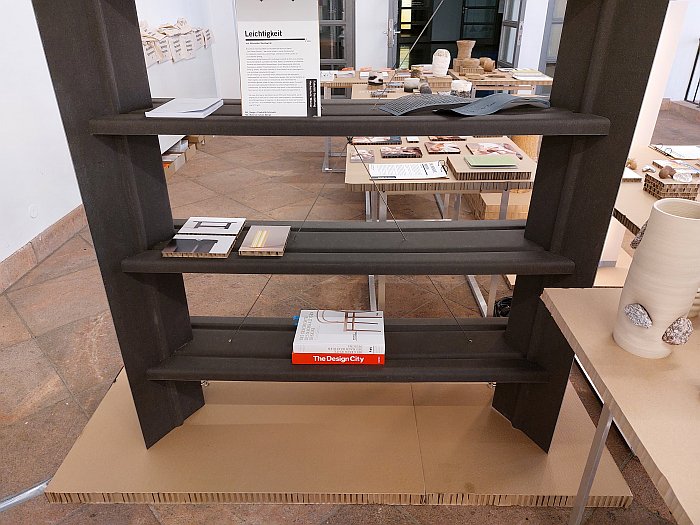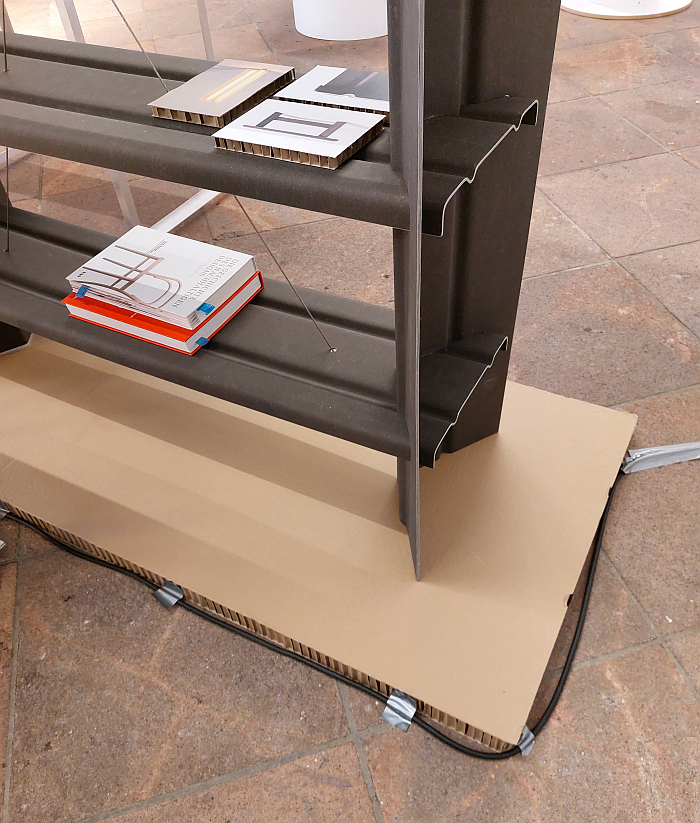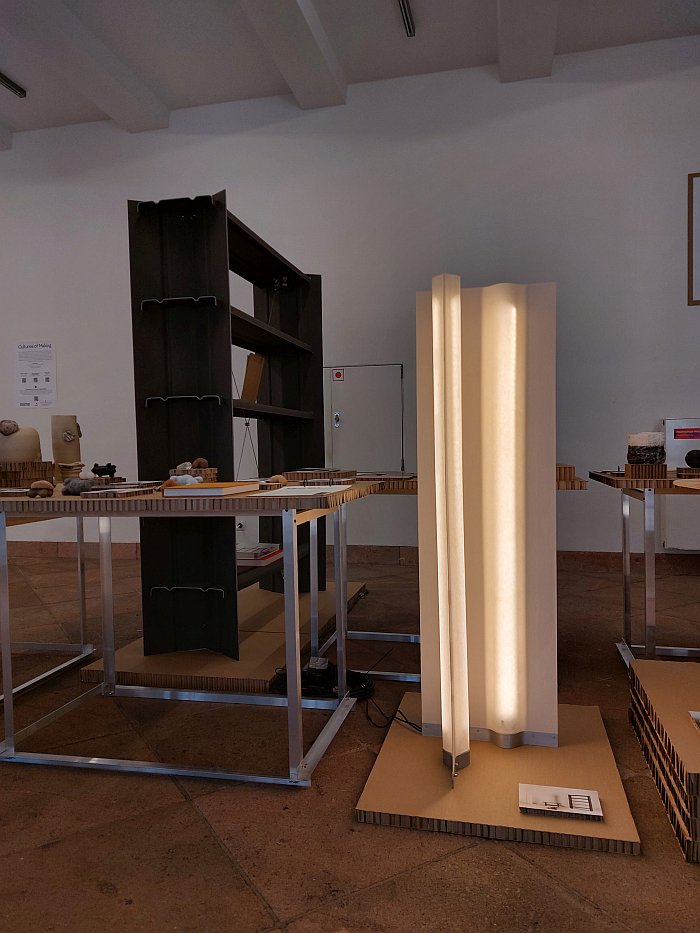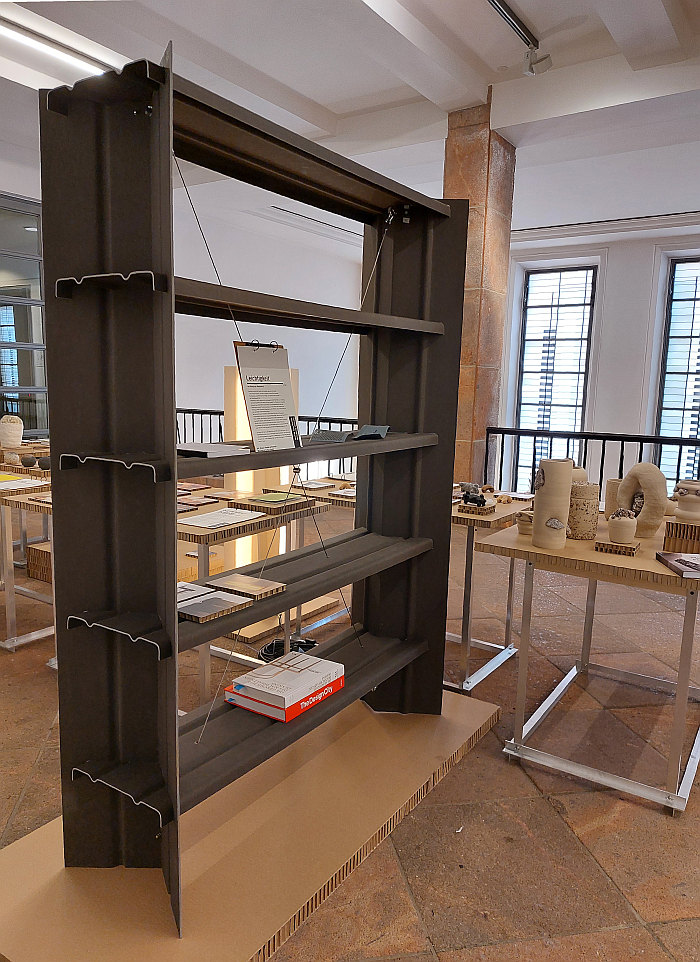
'Do we still need wood, metal and plastic?' asks Hochschule Wismar graduate Aleksander Rasztawicki in context of his Diploma project Leichtigkeit, Lightness.
A rhetorical question for Aleksander doesn't believe that we necessarily do.
For Aleksander all we need is paper.
Or more accurately all we need is vulcanised fibre, a material first patented in 1859 that is produced from cotton via a process which, in many regards, is a further development of the 19th century process of making paper from cotton — for all that today it can be hard to believe that was how paper was made, that was how paper was made — and which, and summarising a little more than is prudent, sees piles of saturated cotton paper pressed to boards that are, essentially, 100% cotton without any additional binders or resins.
A material than can be produced from cotton waste, thereby making it a material of interest in context of today's heightened appreciations of the necessity of ensuring not only that those resources and materials that are no longer needed are recycled/reused, but also also that those materials for which industry has no need, or are left-overs of industrial processing, find a meaningful use.
A material that is characterised by, and amongst other properties, its strength, resilience, tensility, high insulating value, and leichtigkeit. Properties which make it particularly interesting in context of furniture and interiors. As does its use of old/unwanted materials and lack of synthetic chemical additives. If a use for furniture that is barely taken up.
A use for furniture Aleksander sought to explore, demonstrate, argue for, in context of his Diploma project via a bench, a shelving unit and a lamp, the latter two of which could be investigated at Grassimesse 2024 in context of the Hochschule Wismar showcase: the shelving presenting itself as a very simple interlocked structure constructed from moulded vulcanised fibre board; the lamp a most engaging work in which the wings of two hollow vulcanised fibre tubes interlock to support each other while a light source within the tubes produces a diffuse, almost opaque light. So not a bright functional light but very much an atmospheric, background, light.
Shelving and a lamp that mean we don't need wood, metal and plastic?
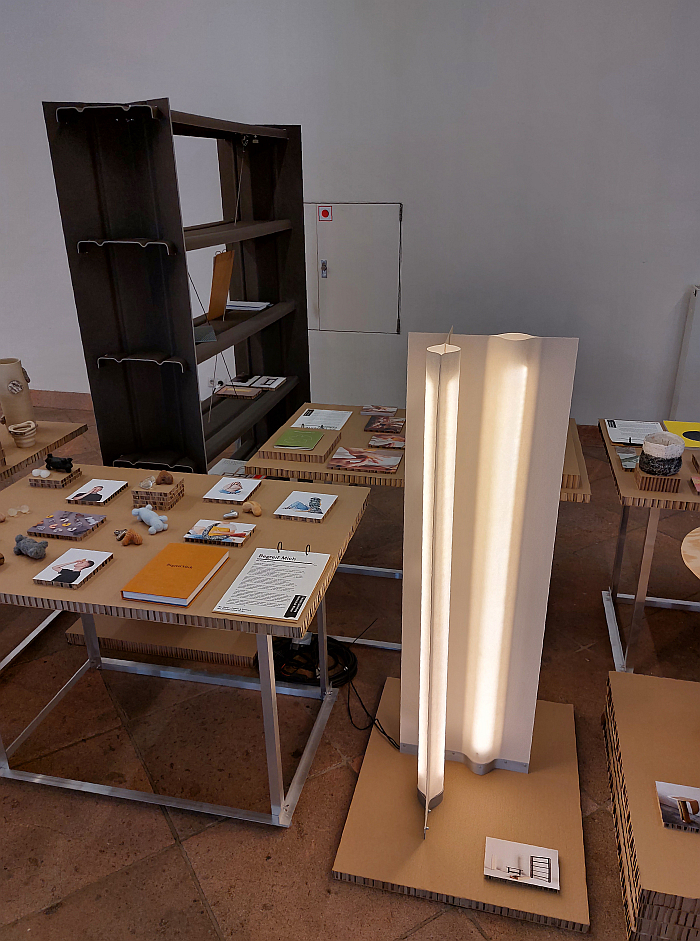
The Grassimesse presentation was way too brief to allow a definitive answer to such a question, although a copy of Aleksander's Diploma thesis was available to peruse by way of helping one approach a possible answer; a very welcome presence if one we admittedly didn't take advantage of. Pressures of time. Lots to see. Lots to do. Lots of obstacles to reading a Diploma thesis. But good that it was there. The theory is always as important as the practice.
But a Grassimesse presentation that, not least amongst the swathes of wood, metal and plastic on display elsewhere both in context of Grassimesse and the Grassi Museum für Angewandte Kunst's permanent collection exhibition, despite its brevity did allow one ample opportunity to reflect on the materials we use for furniture, the materials we use for all our objects of daily use, and also the question of the need for novel materials versus the question of the need for a change of attitude towards materials and the question of the volume of materials we need. Thoughts also stimulated elsewhere in Grassimesse 2024 including by Aleksander's Wismar colleague Johanna Ebert whose project Pinus explores employing pine needles as the basis for novel material, and also by Burg Giebichenstein Halle graduate Karl Anton Schinkel with a material based on shredded waste wood. And also a continuation of thoughts stimulated at Grassimesse 20203 where Matthias Gschwendtner argued via his project New Sources for the use of that wood, not least the branches, that is/are often thrown away. Furniture isn't just about function and art, it's also processing, delivery, marketing, disposal, re-use, amongst a great many other aspects. And also about the materials we use for furniture. And why we use those materials. And why don't use other materials. See also Beetlechair by Alexander von Dombois.
A presentation that also allowed for reflections on the fact that the contemporary answers we're looking for could be behind us, that only looking forward is often part of the problem: vulcanised fibre was developed in the mid-19th century has untold known uses, why isn't more vulcanised fibre widely used for furniture? Because it's old, because we only want the new? The new may be possible, but isn't always desirable, see, for example, delivery drones. Or are there more practical reasons for not using more vulcanised fibre? Or preconceptions, or conditioning? Why don't we eat more mealworms in Europe?
Allowed refections on the cotton which it is based. Or at least did for us: since seeing Moa by Roberta Wende at Design Without Borders 2024 with its seat shell crafted from hemp felt we've spent a lot of time reflecting on the manner in which in the late 19th century, so at that moment when vulcanised fibre was establishing itself as a novel material, hemp and flax production in Europe was increasingly decimated, essentially extinguished, by imported cotton with all the consequences that had for those industries and individuals that relied on hemp and flax cultivation, and the question if that isn't something we shouldn't correct. On the one hand as a means of supporting rural communities and economies, on the other because hemp and flax have a myriad uses that are not irrelevant in contemporary European society, and on the rare and thus particularly valuable third hand, because cotton cultivation and processing isn't exactly the most environmentally friendly and sustainable of realities, certainly not when practised at the vast industrial scales it often is. To paraphrase Aleksander, do we still need cotton?
Allowed for reflection on the Trabant, a car that was made from material closely related to vulcanised fibre, albeit cotton with an added resin, but could the Trabant have been made from vulcanised fibre? Could the DDR have been future-orientated? No, honest, could it have been?
And thus through such and other reflections stimulated by the shelving and lamp Leichtigkeit, Lightness, allowed one to approach in a more nuanced and concentrated, and pleasingly differentiated, fashion not only the question, do we still need wood, metal and plastic, but do we still need vulcanised fibre?
And thereby to approach the more pertinent question of why we need that which we demand.
More information on Aleksander Rasztawicki can be found at www.a-rasztawicki.com and Aleksander's Instagram channel @Aleks_rasztawicki
More information on the Faculty of Architecture and Design at the Hochschule Wismar can be found at https://fg.hs-wismar.de
Grassimesse 2024 has now ended, further information can be found at www.grassimesse.de
